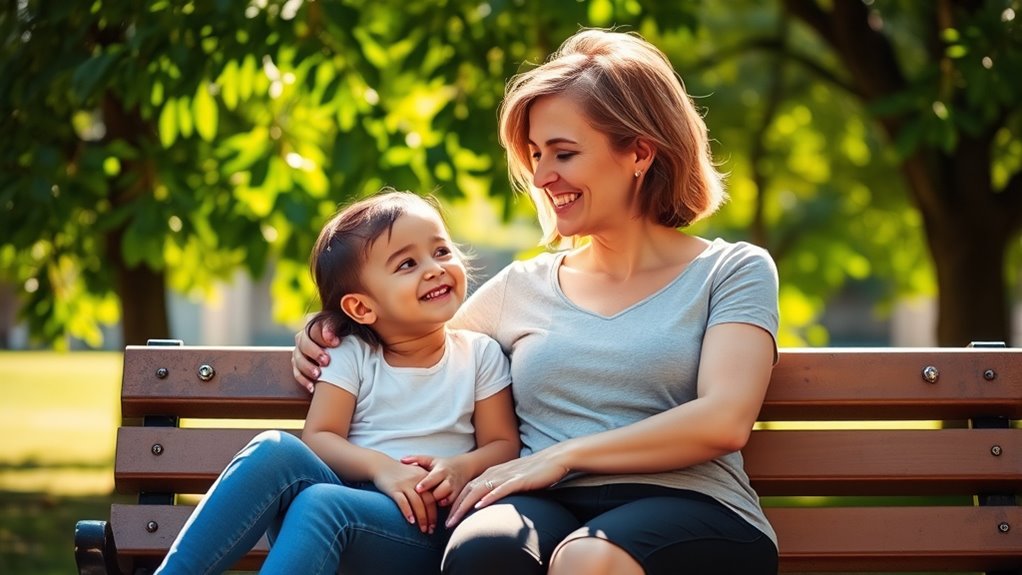Your attachment style shapes how you handle stress and bounce back from challenges. Secure attachment helps you trust others, express emotions healthily, and build resilience. Anxious attachment may make you seek constant reassurance and feel overwhelmed, while avoidant attachment leads you to suppress feelings and withdraw. Disorganized attachment causes emotional chaos and trust issues. Understanding your attachment style opens the door to developing healthier patterns and stronger resilience—if you keep exploring, you’ll uncover ways to nurture emotional strength.
Key Takeaways
- Secure attachment fosters strong emotional regulation skills, enhancing resilience during stress and adversity.
- Insecure attachment patterns (anxious, avoidant, disorganized) can hinder emotional resilience by impairing trust and adaptive coping.
- Recognizing attachment styles helps individuals develop healthier emotional responses and build resilience over time.
- Engaging in attachment-focused exercises, like emotional journaling, promotes self-awareness and resilience-building.
- Supportive relationships reinforce resilience by providing validation, trust, and safe spaces for emotional expression.
Understanding Attachment Styles: The Foundation of Emotional Patterns

Understanding attachment styles is essential because they shape how you connect with others and handle emotional challenges. Your attachment origins, formed in early childhood through interactions with caregivers, influence your emotional regulation strategies. If you experienced consistent support, you’re more likely to develop secure attachment, enabling healthier emotional responses. Conversely, inconsistent or neglectful caregiving can lead to insecure attachment styles, making emotional regulation more difficult. Recognizing your attachment origins helps you understand why you react certain ways in relationships. It reveals how past experiences impact your current ability to manage stress, anxiety, and intimacy. Additionally, attachment styles can influence your resilience in coping with life’s challenges. By understanding these foundational patterns, you gain insight into your emotional responses and can work toward developing healthier ways to cope and connect with others.
The Characteristics of Secure Attachment and Resilience

Secure attachment is characterized by a healthy balance of independence and intimacy, allowing you to trust others and seek support when needed. According to attachment theory, this balance fosters strong emotional regulation skills, helping you manage stress and bounce back from setbacks. People with secure attachment tend to feel confident in their relationships, expressing emotions openly and constructively. They’re resilient because they’re not overwhelmed by negative feelings or fears of abandonment. Instead, they approach challenges with a sense of stability and self-assurance. This emotional resilience stems from a positive view of oneself and others, which makes it easier to navigate difficult situations. Overall, secure attachment helps you develop adaptive coping strategies, strengthening your ability to handle life’s ups and downs effectively.
How Anxious Attachment Influences Stress Management

If you have an anxious attachment style, you might find yourself clingy or overly dependent when managing stress. Your fear of abandonment can make it harder to stay calm during challenging times, as you seek constant reassurance. Understanding these tendencies can help you develop healthier ways to cope under pressure. Additionally, exploring risk assessment strategies can empower you to recognize and address your emotional vulnerabilities more effectively.
Clinginess and Overdependence
Clinginess and overdependence are common traits among individuals with anxious attachment styles, often causing them to seek constant reassurance from others. This emotional dependency can lead to codependency, where your sense of self-worth depends heavily on others’ validation. You might find yourself overly worried about losing loved ones, which fuels your need for closeness and reassurance. Such behaviors can become a cycle, increasing stress and making it harder to manage your emotions independently. Your desire for connection may cause you to cling even more tightly, fearing abandonment or rejection. Recognizing this pattern is vital, as it helps you understand how anxious attachment influences your stress responses. Developing healthier boundaries and building self-confidence can gradually reduce clinginess and foster emotional resilience. Understanding your attachment style can also help you identify effective coping strategies to improve your emotional well-being.
Fear of Abandonment
Have you ever noticed how the fear of abandonment can intensify your stress levels? When attachment triggers arise, especially abandonment fears, you may find yourself overwhelmed or anxious. These triggers activate deep-seated worries that your loved ones might leave, making it harder to manage stress effectively. Anxious attachment styles often amplify this response, causing you to seek constant reassurance or overanalyze interactions. Instead of addressing challenges calmly, you might react impulsively, fearing rejection or separation. Recognizing these attachment triggers is vital for managing your stress and building emotional resilience. By understanding how fears of abandonment influence your reactions, you can work toward healthier coping strategies, fostering a sense of security and reducing the impact of attachment triggers on your well-being. Additionally, understanding the emotional effects of narcissistic abuse can help you develop strategies to recover and strengthen your resilience over time.
Avoidant Attachment and Its Impact on Emotional Recovery

Avoidant attachment styles can considerably hinder emotional recovery by fostering a tendency to suppress or distance yourself from difficult feelings. When you rely heavily on emotional independence and self-reliance, you might avoid seeking support or expressing vulnerability, which are vital for healing. This detachment can lead you to shut down emotionally, making it harder to process pain or setbacks. Over time, you may believe that handling everything alone is a strength, but it often prevents you from fully confronting and working through emotions. As a result, recovery becomes more challenging, and unresolved feelings can accumulate. Recognizing the importance of emotional communication can help in overcoming avoidance and fostering resilience. To foster resilience, it’s essential to recognize when avoidance limits your growth and to practice embracing your emotions, even if it feels uncomfortable at first.
The Challenges of Disorganized Attachment in Emotional Coping

With disorganized attachment, your emotional responses can feel confusing and unpredictable, making it hard to understand what you’re feeling. Trust issues and lingering anxiety often emerge, affecting how you connect with others. These challenges create a complex barrier to developing healthy coping strategies and emotional resilience. Recognizing dog breeds that are known for their loyal and gentle nature, such as Golden Retrievers, can serve as a comforting reminder of the importance of trust and companionship in healing emotional wounds.
Confusion in Emotional Responses
Disorganized attachment often leads to confusion in emotional responses, making it difficult to interpret and manage feelings effectively. You might find yourself overwhelmed by emotional triggers that seem to come out of nowhere, leaving you unsure of how to respond. Your response patterns may clash, swinging between intense reactions and emotional withdrawal, which only adds to the uncertainty. This confusion can cause you to:
- Misread your feelings and the emotions of others
- React impulsively or suppress emotions altogether
- Struggle to distinguish between genuine feelings and fears
- Feel stuck in a cycle of emotional unpredictability
- Suction power in your emotional reactions can influence how deeply you experience or suppress feelings, further complicating your ability to develop emotional resilience.
This pattern keeps you from understanding your true emotional needs, creating a tangled web of responses that hinder emotional resilience and clarity.
Trust Issues and Anxiety
Have you ever noticed how trust can feel fragile or elusive when you’re struggling with disorganized attachment? Trust issues often surface as anxiety triggers, making it hard to feel secure in relationships. Your mind may swing between wanting closeness and fearing abandonment, intensifying emotional chaos. This push-pull pattern heightens anxiety, leaving you overwhelmed. To better understand, consider this table:
| Trust Issues | Anxiety Triggers |
|---|---|
| Fear of betrayal | Sudden separation fears |
| Doubts about others’ intentions | Feeling misunderstood or ignored |
These patterns reinforce disorganized attachment, making emotional resilience difficult. Recognizing these triggers helps you manage anxiety better and gradually build trust, despite the emotional challenges you face. Additionally, understanding the vetted strategies for emotional resilience can empower you to develop healthier coping mechanisms over time.
Recognizing Your Attachment Style to Enhance Resilience

Understanding your attachment style is a crucial step toward building emotional resilience. By identifying your style, you become more aware of attachment triggers that influence your reactions and relationships. This awareness helps you recognize patterns in your emotional responses and develop healthier coping mechanisms. To start, reflect on situations that evoke strong feelings or discomfort—these often signal attachment-related triggers. Pay attention to your emotional awareness during conflicts or moments of vulnerability. You might notice tendencies like withdrawal, clinginess, or difficulty trusting others. Recognizing these signs allows you to understand your attachment style better and how it shapes your resilience. Remember, self-awareness is key in transforming emotional responses and strengthening your ability to recover from setbacks. Additionally, understanding juice recipes and mixes can serve as a metaphor for blending different emotional ingredients to create a balanced resilience.
Strategies to Develop a Secure Attachment for Better Emotional Health

Developing a secure attachment style is essential for improving your emotional health and fostering healthier relationships. One effective strategy is engaging in attachment exercises that focus on building trust and emotional awareness. These exercises help you recognize your needs and express vulnerability safely. Additionally, emotional journaling can be a powerful tool; by writing about your feelings, past experiences, and attachment patterns, you gain clarity and insight into your emotional landscape. Consistently practicing these techniques encourages self-awareness and helps reframe negative beliefs about intimacy and dependence. Incorporating understanding of attachment styles can further inform your approach and promote healthier relational patterns. Over time, these strategies strengthen your ability to form secure attachments, making you more resilient emotionally. Remember, developing a secure attachment is a gradual process that benefits from patience, consistency, and self-compassion.
The Role of Relationships in Strengthening Emotional Resilience

Relationships play a crucial role in strengthening emotional resilience because they provide support, validation, and opportunities for growth. When you feel safe to express your emotions openly, you build trust and deepen your connections. Healthy relationships encourage emotional expression, helping you process feelings rather than suppress them. Setting clear relationship boundaries is essential; they protect your well-being and ensure mutual respect. Strong bonds teach you resilience by showing you that you’re not alone during tough times. Here’s how relationships boost resilience:
- Offer a safe space for honest emotional expression
- Reinforce the importance of respecting boundaries
- Provide comfort during setbacks
- Foster personal growth through shared experiences
Frequently Asked Questions
Can Attachment Styles Change Over a Lifetime?
Yes, your attachment style can change over a lifetime. You have the potential for attachment style flexibility as you experience new relationships and personal growth. Lifelong attachment development means your patterns aren’t fixed; they evolve based on your experiences, healing, and self-awareness. By actively working on understanding yourself and your relationships, you can develop healthier attachment patterns, leading to more secure connections over time.
How Do Childhood Experiences Shape Adult Attachment Styles?
Did you know that childhood experiences profoundly influence your adult relationships? Early bonding with caregivers and parental influence shape your attachment style, affecting trust and intimacy later in life. If you experienced consistent love and support, you’re likely to develop a secure attachment. Conversely, inconsistent or neglectful care can lead to insecure styles, making it harder to form healthy connections. Your early relationships truly lay the foundation for your adult emotional life.
What Role Does Therapy Play in Improving Attachment Security?
Therapy plays a vital role in improving attachment security by guiding you through therapeutic techniques that foster emotional healing. You actively explore past experiences, recognize patterns, and develop healthier ways to connect. With consistent effort, therapy helps you build trust, manage emotional responses, and strengthen your relationships. By addressing underlying issues, you gain resilience and feel more secure emotionally, ultimately enhancing your overall well-being and ability to form meaningful connections.
Are Attachment Styles Inherited Genetically or Learned?
You might wonder if attachment styles are inherited genetically or learned behaviors. While genetic influence can play a role, most experts agree that attachment styles are primarily learned through your early experiences with caregivers. These interactions shape how you trust, seek comfort, and relate to others. So, your attachment style develops over time based on your environment and relationships, though genetics can influence your temperament and emotional responses.
How Does Attachment Style Affect Romantic Relationship Longevity?
While some believe love’s fate is unpredictable, your attachment dynamics directly influence relationship stability. If you have a secure attachment style, you’re more likely to build lasting bonds, whereas insecure styles can cause frequent conflicts and breakups. Recognizing how your attachment patterns shape your responses helps you foster healthier connections, strengthening your romantic longevity. Your awareness of these dynamics empowers you to nurture more resilient and enduring relationships over time.
Conclusion
Understanding your attachment style reveals the secret to unstoppable emotional resilience. By recognizing whether you lean towards secure, anxious, avoidant, or disorganized attachment, you can actively transform your emotional responses. Building secure attachments isn’t just helpful—it’s like arming yourself with an invincible shield against life’s storms. Embrace this knowledge, nurture healthy relationships, and watch your emotional strength skyrocket to heights even the stars would envy. Your resilient future begins now—are you ready to take that first step?









